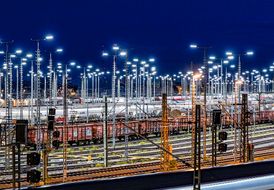Freight transport and logistics
ANTICIPATED MARKET DEVELOPMENT / % | 2021 | 2022 |
German freight transport (based on tkm) | +4.5 | +3.0 |
European rail freight transport (based on tkm) | +7.2 | +3.0 |
European land transport (based on revenues) | +7.6 | +5.0 |
Global air freight (based on t) | +18.4 | +4.0 |
Global ocean freight (based on TEU) | +5.0 | +3.0 |
Global contract logistics (based on revenues) | +8.4 | +5.5 |
As of February 2022. Forecasts for 2022 rounded to half percentage points.
The freight market is expected to see a more moderate, yet still strong, increase in output in 2022 compared to 2021. It is generally assumed that the supply chain bottlenecks that occurred in 2021 will weaken over the course of the year. However, aggravations are expected from the war in Ukraine. The delayed recovery in some sectors will also have knock-on effects on demand for transport and will continue to have an impact up to 2023. The market will continue to be characterized by sustained competitive pressure. In addition to prices, the quality of transport services will become increasingly important as resources become scarcer.
Rail freight transport will return to a growth path following the declines from 2018 to 2020 and the strong increase in performance in 2021. Combined transport will once again play a key role if the impetus from the coal and steel industry is expected to weaken. This trend is also being driven by the increasing importance of sustainable transport and the growing customer demand for a shift in the mode of transport to rail.
Following the dynamic development in 2021, growth in road freight transport will slow in 2022, but will remain strong overall. Stimulating factors will include robust consumer sentiment, a dynamic foreign trade environment and positive effects from the construction sector. The war in Ukraine will have a dampening effect.
In 2021, inland waterway transport was still unable to offset the previous year’s losses, meaning that the recovery should continue in 2022. This applies in particular to the area of mineral oil transport. However, as a result of the weakening impetus from the coal and steel industry and the low importance of container transport in terms of the freight structure, the overall trend is again likely to be below average. Weather dependency remains a risk.
Assuming further economic stabilization, the European rail freight transport market is expected to return to a moderate growth path in 2022. Combined transport in particular will benefit from the continued dynamic development of European foreign and domestic trade and will play a growth-driving role.
- Revenues in the European land transport market are expected to return to pre-Covid-19 levels in 2022. The driver for this development is the economic recovery in Europe. Revenues from international land transport business are expected to exceed pre-Covid-19 levels, while domestic transport services are expected to remain just below pre-Covid-19 levels. The effects of the war in Ukraine may have a dampening effect here, particularly in the first half of 2022.
- For American land transport, the current conditions are expected to continue in 2022. All indicators point to a continued shortage of truck capacity, with freight forwarders increasing their rates and being much more selective in awarding contracts. The spot market will most likely grow more strongly than the contract market, at least in the first half of 2022, as freight forwarders will take advantage of high rates before making long-term commitments.
- Intra-Asian land transport will benefit from the economic recovery, after the Covid-19 pandemic has been overcome.
- The continued slow resumption of (air) travel activities in 2022 is unlikely to be sufficient to cause a noticeable reduction in extraordinarily high air freight rates through increased freight capacities. The uncertainties and travel restrictions caused by the Covid-19 pandemic remain too great. The ongoing capacity bottlenecks in ocean freight will also continue to lead to a tense order situation for air transport. Developments from political decisions may also influence market developments, such as further sanctions against Russia.
- The outlook for the global ocean freight market is heavily dependent on the extent to which the container ship congestion in ports, which continues to exist and is increasing as a result of short-term Covid-19 restrictions, can be relieved. As long as the demand for transport space exceeds capacity, rates are not expected to recover in the short term.
- The contract logistics market expects subdued growth in 2022. The Asia-Pacific and American markets will continue to see single-digit growth, while the European market is expected to recover to pre-Covid-19 levels.
- In the e-commerce, healthcare and electronics divisions, we expect solid business development, while the automotive market will continue to suffer from the negative impact of chip supply bottlenecks. Risks continue to result from the unpredictable development of the Covid-19 pandemic and its impact on the global macroeconomy, as well as from the increasing challenges in the areas of high inflation, the real estate market and the labor market.



